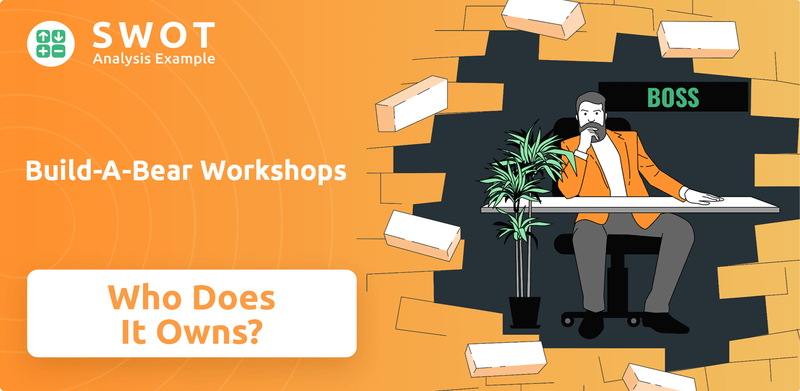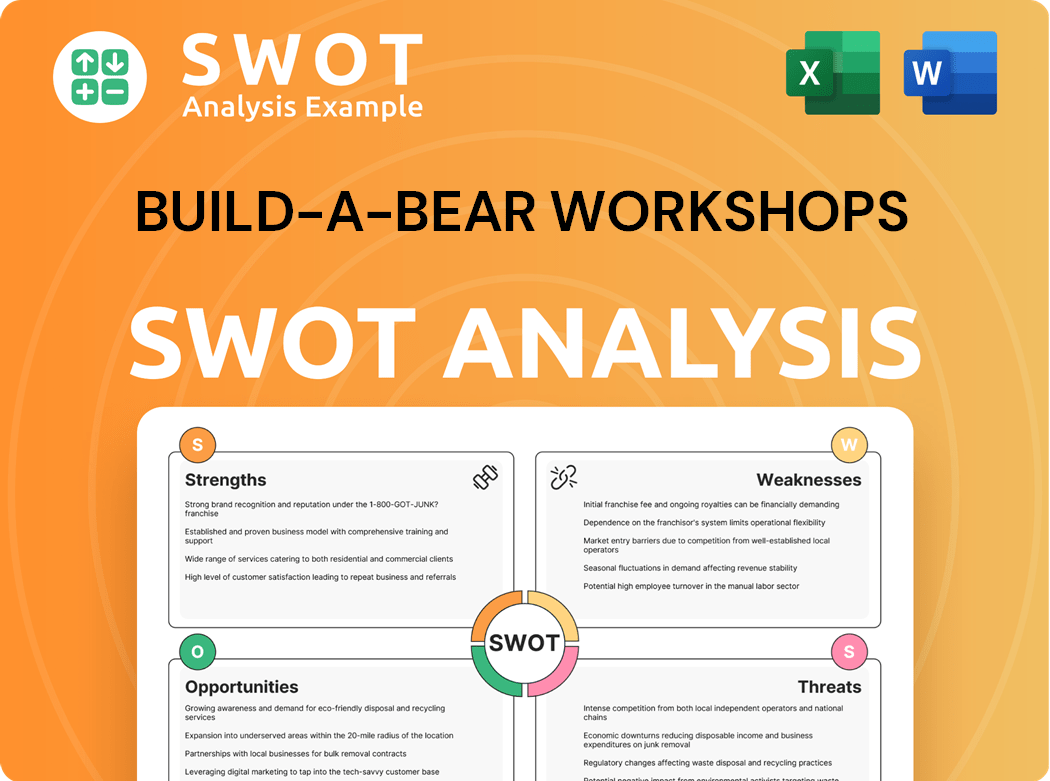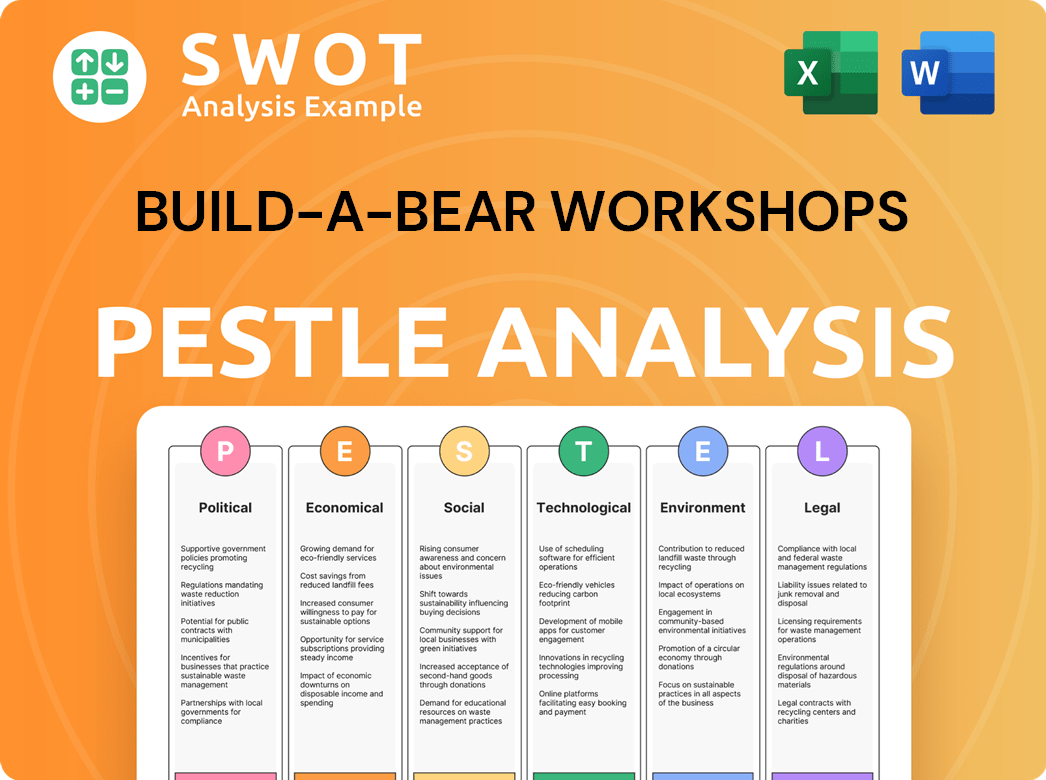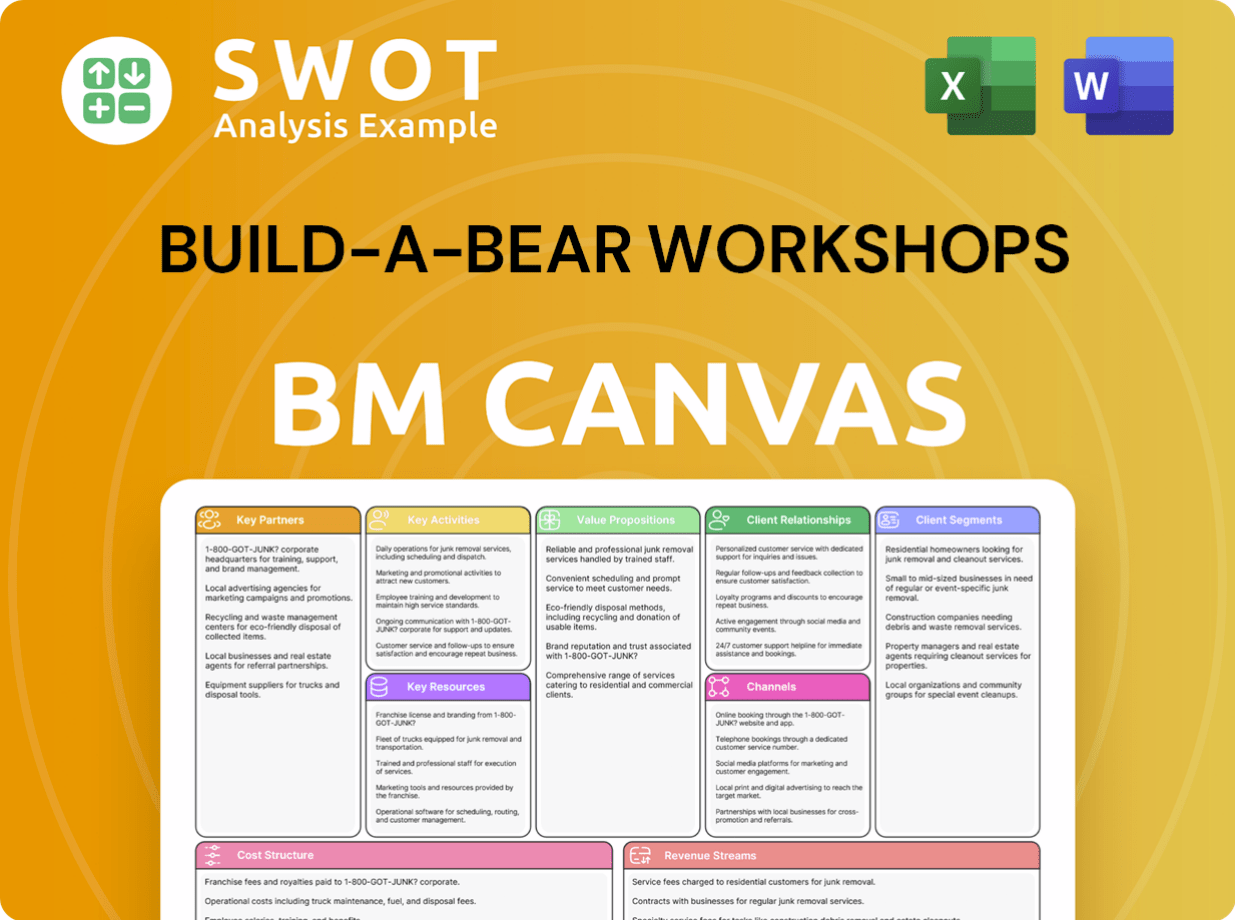Build-A-Bear Workshops Bundle
Who Really Owns Build-A-Bear Workshop?
Unraveling the ownership of Build-A-Bear Workshop is key to understanding its strategic moves and financial health. Knowing "who owns Build-A-Bear" illuminates its decision-making processes and its responsiveness to market changes. This insight is crucial for investors and anyone interested in the Build-A-Bear Workshops SWOT Analysis, and the company's long-term prospects.

Understanding the Build-A-Bear ownership structure is vital, especially considering its position as a publicly traded entity. The Build-A-Bear company's history, from its founding by Maxine Clark to its current status, reveals a fascinating evolution. Exploring the Build-A-Bear owner and its shareholders provides valuable context for evaluating the company's future, including its stock performance and strategic direction. The Build-A-Bear stock symbol and its publicly traded status are also important factors.
Who Founded Build-A-Bear Workshops?
The origins of Build-A-Bear Workshop, a company known for its interactive retail experience, trace back to 1997. The company was founded by Maxine Clark, whose vision would shape the brand's unique approach to the retail market. Understanding the early ownership structure is key to grasping how the company evolved from a startup to a publicly traded entity.
Maxine Clark, the driving force behind Build-A-Bear, had a strong background in retail. Her experience at May Department Stores and Payless ShoeSource provided her with the expertise to launch a successful retail venture. The initial concept for Build-A-Bear emerged from a shopping trip, highlighting Clark's ability to identify a gap in the market and create a distinctive customer experience.
The early financing of Build-A-Bear likely involved a mix of personal investment, angel investors, and potentially venture capital. While specific details on the initial equity splits are not publicly available, Clark's leadership was crucial in securing the necessary funding. This initial phase set the stage for the company's growth and its eventual path to becoming a publicly traded company.
Build-A-Bear Workshop was founded in 1997.
The founder of Build-A-Bear is Maxine Clark.
Early funding likely included personal capital, angel investors, and venture capital.
Maxine Clark had experience at May Department Stores and Payless ShoeSource.
The idea for Build-A-Bear originated from a shopping trip.
Early ownership was concentrated among Clark and early investors.
The initial ownership structure of Build-A-Bear, involving Maxine Clark and early investors, was crucial for the company's early success. The focus was on establishing a strong brand and expanding the number of stores. While the specifics of early ownership agreements remain largely private, the company's growth trajectory indicates a stable foundation. For more information on the company's history, you can read more about the Build-A-Bear Workshops company overview.
Build-A-Bear Workshops SWOT Analysis
- Complete SWOT Breakdown
- Fully Customizable
- Editable in Excel & Word
- Professional Formatting
- Investor-Ready Format

How Has Build-A-Bear Workshops’s Ownership Changed Over Time?
The journey of Build-A-Bear Workshop, Inc. into the public domain began in 2004. The initial public offering (IPO) on the New York Stock Exchange (NYSE) under the ticker 'BBW' was a pivotal moment. It transformed the company from a privately held entity to one with public ownership, providing early investors and the founder with an avenue for liquidity. This transition to being Build-A-Bear Workshops' marketing strategy was a key step in the company's evolution, influencing its strategic direction and financial strategies.
As of early 2025, the ownership of Build-A-Bear is largely held by institutional investors, mutual funds, and individual shareholders. This shift has brought increased scrutiny from the market and shareholders, affecting decisions related to expansion, digital initiatives, and capital allocation. This includes decisions on stock buybacks and dividend policies.
| Event | Impact | Date |
|---|---|---|
| Initial Public Offering (IPO) | Transitioned from private to public ownership, increased liquidity. | 2004 |
| CEO Transition | Founder Maxine Clark stepped down as CEO. | 2013 |
| Institutional Investment | Increased influence from investment firms and funds. | Ongoing |
Key institutional shareholders, including firms like BlackRock and The Vanguard Group, hold significant stakes. As of the end of 2024, institutional ownership accounted for a substantial percentage of outstanding shares, reflecting confidence in the company's long-term strategy. While Maxine Clark's influence remains, her direct ownership stake has likely diminished over time. The company's current market capitalization and stock price history are subject to market fluctuations, with detailed financial information available through SEC filings and financial news sources.
The ownership structure of Build-A-Bear has evolved significantly since its IPO in 2004. The company is now primarily held by institutional investors and individual shareholders.
- Institutional investors hold a substantial portion of the shares.
- The founder's direct ownership has likely decreased over time.
- The company's strategic decisions are influenced by shareholder and market scrutiny.
- Key institutional investors include firms like BlackRock and The Vanguard Group.
Build-A-Bear Workshops PESTLE Analysis
- Covers All 6 PESTLE Categories
- No Research Needed – Save Hours of Work
- Built by Experts, Trusted by Consultants
- Instant Download, Ready to Use
- 100% Editable, Fully Customizable

Who Sits on Build-A-Bear Workshops’s Board?
As of early 2025, the Board of Directors of the Build-A-Bear Workshop, Inc. oversees the company's strategic direction and governance. The board's composition typically includes a blend of independent directors, executive directors (including the CEO), and potentially representatives of significant shareholders. These board members bring a variety of expertise in areas such as retail, finance, marketing, and operations. Understanding who owns Build-A-Bear is crucial for investors and stakeholders alike, and the board plays a key role in representing shareholder interests.
The board's structure and decisions are transparently disclosed in the company's proxy statements, offering insights into its governance practices. For those interested in the Brief History of Build-A-Bear Workshops, understanding the evolution of its leadership and ownership is essential. The board's decisions are determined by majority vote, reflecting the collective will of the shareholders, which ensures accountability.
| Board Member | Title | Relevant Experience |
|---|---|---|
| Sharon Price John | CEO and Director | Extensive experience in retail and consumer products, leading the company's strategic direction. |
| Voin Todorovic | Lead Independent Director | Financial and operational expertise, providing independent oversight and guidance. |
| Richard E. Bressler | Independent Director | Experience in finance and investment, contributing to financial strategy and planning. |
The voting structure for Build-A-Bear Workshop follows a one-share-one-vote principle. This means that each share of common stock carries one vote, ensuring that voting power is directly proportional to the number of shares owned. This structure is common for public companies listed on major exchanges. There are no indications of dual-class shares or special voting rights. The board remains accountable to all shareholders. Board elections and key corporate decisions are determined by majority vote, reflecting the collective will of the shareholders. Build-A-Bear is a publicly traded company, and understanding the Build-A-Bear ownership structure is key for investors.
The Board of Directors oversees Build-A-Bear's strategic direction, with a mix of independent and executive directors.
- The voting structure is one-share-one-vote, ensuring shareholder power is proportional to ownership.
- Board decisions are made by majority vote, reflecting the will of the shareholders.
- The company's governance practices are transparently disclosed in proxy statements.
- Understanding the board's composition is key to understanding Build-A-Bear ownership.
Build-A-Bear Workshops Business Model Canvas
- Complete 9-Block Business Model Canvas
- Effortlessly Communicate Your Business Strategy
- Investor-Ready BMC Format
- 100% Editable and Customizable
- Clear and Structured Layout

What Recent Changes Have Shaped Build-A-Bear Workshops’s Ownership Landscape?
Over the past few years (2022-2025), the ownership landscape of the Build-A-Bear company has been shaped by strategic initiatives and market dynamics. Build-A-Bear, a publicly traded entity, continues to adapt to evolving retail trends. The company's focus on digital expansion and diversification of its retail footprint influences investor sentiment and, indirectly, its ownership structure. Furthermore, share buyback programs, if implemented, could affect the earnings per share, potentially impacting the value for existing Build-A-Bear shareholders.
The industry trend indicates a rise in institutional ownership across many public companies. For Build-A-Bear, this could mean a further concentration of ownership among institutional investors. Founder dilution is a natural part of a publicly traded company's evolution. Strategic moves, such as collaborations and new product lines, aim to enhance shareholder value and attract continued investment. Understanding the Revenue Streams & Business Model of Build-A-Bear Workshops is crucial for investors. While no significant shifts in ownership structure have been publicly announced, the company's performance and market conditions will always play a role in future ownership considerations.
| Metric | Value (as of Q1 2024) | Source |
|---|---|---|
| Market Capitalization | Approximately $200 million | Financial News Sources |
| Institutional Ownership | Around 60% | Financial News Sources |
| Revenue (2023) | Approximately $467.9 million | Build-A-Bear Workshop, Inc. - SEC Filings |
The company's market capitalization as of early 2024 was approximately $200 million. Institutional ownership hovers around 60%, indicating a strong presence of large investors. Build-A-Bear's revenue for 2023 was about $467.9 million, according to the company's SEC filings.
Build-A-Bear is a publicly traded company, meaning its ownership is distributed among various shareholders. Major investors include institutional investors, such as investment firms and mutual funds, who hold a significant portion of the outstanding shares. The ownership structure can change over time due to market activities and company decisions.
Key shareholders in Build-A-Bear include both institutional investors and potentially some individual investors. These key shareholders can influence the company's strategic decisions and financial performance. The specific names and percentages of ownership for major investors are available in public filings.
The ownership structure directly impacts the company's strategic direction. Institutional investors often focus on long-term value creation. Build-A-Bear's leadership team and board of directors make decisions that align with shareholder interests. Strategic initiatives aim to enhance shareholder value and attract continued investment.
Future ownership considerations for Build-A-Bear will be influenced by market conditions, company performance, and strategic decisions. Potential changes could include further institutional investment, share buybacks, or other actions. The company's financial health and strategic direction will be key factors.
Build-A-Bear Workshops Porter's Five Forces Analysis
- Covers All 5 Competitive Forces in Detail
- Structured for Consultants, Students, and Founders
- 100% Editable in Microsoft Word & Excel
- Instant Digital Download – Use Immediately
- Compatible with Mac & PC – Fully Unlocked

Related Blogs
- What are Mission Vision & Core Values of Build-A-Bear Workshops Company?
- What is Competitive Landscape of Build-A-Bear Workshops Company?
- What is Growth Strategy and Future Prospects of Build-A-Bear Workshops Company?
- How Does Build-A-Bear Workshops Company Work?
- What is Sales and Marketing Strategy of Build-A-Bear Workshops Company?
- What is Brief History of Build-A-Bear Workshops Company?
- What is Customer Demographics and Target Market of Build-A-Bear Workshops Company?
Disclaimer
All information, articles, and product details provided on this website are for general informational and educational purposes only. We do not claim any ownership over, nor do we intend to infringe upon, any trademarks, copyrights, logos, brand names, or other intellectual property mentioned or depicted on this site. Such intellectual property remains the property of its respective owners, and any references here are made solely for identification or informational purposes, without implying any affiliation, endorsement, or partnership.
We make no representations or warranties, express or implied, regarding the accuracy, completeness, or suitability of any content or products presented. Nothing on this website should be construed as legal, tax, investment, financial, medical, or other professional advice. In addition, no part of this site—including articles or product references—constitutes a solicitation, recommendation, endorsement, advertisement, or offer to buy or sell any securities, franchises, or other financial instruments, particularly in jurisdictions where such activity would be unlawful.
All content is of a general nature and may not address the specific circumstances of any individual or entity. It is not a substitute for professional advice or services. Any actions you take based on the information provided here are strictly at your own risk. You accept full responsibility for any decisions or outcomes arising from your use of this website and agree to release us from any liability in connection with your use of, or reliance upon, the content or products found herein.